Geochemical significance of tricyclic and tetracyclic terpanes in source rock extracts from the Offshore Niger Delta Basin,Nigeria
Abiodun B.Ogbesejana·Oluwasesan M.Bello·Tijjani Ali·Uduma A.Uduma·Kamaluddeen S.Kabo·Oluwadurotimi O.Akintade
Abstract Tricyclic and tetracyclic terpanes are important constituents of crude oil and source rock extracts.However,they have not been reported in the Offshore Niger Delta Basin,Nigeria.Thus,the present study investigated the geochemical significance of tricyclic and tetracyclic terpanes in source rock extracts from the Offshore Niger Delta Bain,Nigeria with gas chromatography-mass spectrometry(GC-MS).The total relative abundances of tricyclic terpanes,C19TT-C21TT,and C23TT in the rock samples ranged from 82.50 to 96.37%,50.08 to 74.17%,and 25.83 to 49.92%,respectively.These values showed the source rocks were formed from a mixed origin(terrestrial and marine).Among the tricyclic and tetracyclic terpanes identified in the rock extracts,the conventional(C20TT,C23TT,C24TT,C24TeT)and recent(Y1,X1,Z1)were more prominent than all others,indicating mixed input of terrigenous and marine organic matter.The C24TT/C23TT,C24TeT/(C24TeT+C26TT),C19TT/C23TT,C20TT/C23TT,C25TT/C24TeT,C25TT/C26TT,C19TT/C20TT,C24TeT/C26TT,Z1/(Z1+C24TT),and Y1/(Y1+C24TT)in the rock samples range from 0.33 to 1.30,0.76 to 0.90,0.18 to 0.73,0.34 to 1.05,0.33 to 1.74,0.30 to 1.39,0.31 to 0.89,1.66 to 4.33,0.36 to 0.83,and 0.34 to 0.79,respectively.These values further showed that the rock samples were formed from mixed input of terrigenous and marine organic matter and deposited under oxic to suboxic conditions in lacustrine-fluvial/deltaic environments.Also,the C24TeT/C20-26TT,C24TeT/C30HOP,and C23TT/C30HOP ranged from 0.16 to 0.45,0.02 to 0.42,and 0.01 to 0.48,respectively.This range of values suggests that source rocks were within immature to early mature stage.Thus,this study showed that tricyclic and tetracyclic terpanes were effective in determining the origin,depositional environments,and thermal maturity of source rocks in the Niger Delta Basin,Nigeria.
Keywords Tricyclic terpanes·Tetracyclic terpanes·Source rocks·Niger delta·Gas chromatography-mass spectrometry(GC-MS)
1 Introduction
Tricyclic and tetracyclic triterpanes are typical constituents of crude oils,bitumen,source rock,and coal extracts.Tricyclic terpanes were first identified in a Green River Formation extract(Anders and Robinson 1971;Gallegos 1971).They usually occur in pseudo-homologous series ranging from Cto C.However,they are commonly recognized up to C,because hopanes often cover the higher members in a mass chromatogram of m/z 191.They are widely applied in oil-oil and oil-source rocks correlation studies because of their effectiveness in determining the origin,depositional conditions,and thermal maturity of geological samples.
Many biological precursors of tricyclic terpane have been proposed.For instance,Ourisson et al.(1982)claimed that tricyclic terpanes might likely derive from prokaryotic cell membranes.In contrast,some researchers(Volkman et al.1989;Simoneit et al.1990,1993;Aquino Neto et al.1992;Azevedo et al.1992)later detected significant quantities of the tricyclic terpanes in Tasmanite oil shale extracts,suggesting Tasmanites which is a family of extinct algae as a possible precursor of tricyclic terpanes.Additionally,Dutta et al.(2006)discovered that pyrolysates of the genus Leiosphaeridias contained tricyclic terpenoids,whereas the Tasmanite family did not contain any of these in a study of well-preserved Tasmanites and Leiosphaeridias prasinophytes in Silurian-Devonian sedimentary rocks from southeastern Turkey.This finding reflects that the Tasmanite-tricyclic terpane source relationship may not always be accurate and that other algal groups are a source of tricyclic terpanes,in addition to Tasmanite.Also,the cracking of sesterpanes and triterpanes had been proposed as an effective source tricyclic terpanes(Aquino Neto et al.1983).
Tricyclic terpanes ranging from C-C,were first identified in crude oils by Moldowan et al.(1983),and their distributive characteristics were studied in crude oils and sediment extracts from different depositional environments(Aquino Neto et al.1983).Many researchers have suggested that moderately high amounts of Ctetracyclic terpane could infer the contribution of terrestrial organic matter(Zhang and Huang 2005;Philp and Gilbert 1986;Boreham et al.2003).Nevertheless,other studies have shown that moderate quantities of Ctetracyclic terpane might suggest a carbonate-evaporite environment(Clark and Philp 1989;Seifert 1978).C-des-A-oleanane and C-des-A-lupane have been reported in Holocene(Bechtel et al.2007)and recently,in Eocene source rock extracts(Chattopadhyay and Dutta 2014).Samuel et al.(2009,2010)detected novel tricyclic terpanes Cand Cand a tetracyclic terpane Cin oils from the Niger Delta(Nigeria),Assam(India),and Beaufort-Mackenzie(Canada)basins and they believed that the compounds originate from oleanoid precursors in angiosperms.
Furthermore,more tri-and tetracyclic terpanes have been identified in source rock extracts and crude oils as a result of their significances in organic geochemistry.For instance,Woodhouse et al.(1992)unequivocally identified a new series of Ctetracyclic terpanes in several tertiary oils by tandem mass spectrometry and proposed that they originate from terrigenous organic matter.Recently,Xiao et al.(2018)identified two tricyclic(compounds X and Y)and four tetracyclic terpanes(compounds X1,Y1,Z and Z1)as C-des-A-lupane,C-des-A-oleanane,C-des-Aursane,and Ctetracyclic terpane,respectively in crude oils from Pearl River Mouth,Beibuwan and Liaohe basins in China and proposed that they have similar attributes in their chemical structures to oleanane,ursane,and lupane and are considered likely to derive from alcohols or ketone precursors present in higher plants.
Although,Samuel et al.(2009,2010)have reported tricyclic and tetracyclic terpanes in the crude oils from Niger Delta Basin no work on these tricyclic and tetracyclic terpanes has been reported on the source rocks from the Offshore Niger Delta Basin.However,Atoyebi et al.(2017)have reported tricyclic and tetracyclic terpanes in the source rocks from Northwestern and Central Niger Delta Basin,Nigeria with the application of few tricyclic terpane ratios discussed.Furthermore,previous studies on tricyclic and tetracyclic terpanes from Niger Delta Basin have principally focused on their structural identifications and possible biological origins(Samuel et al.2009,2010).The distribution and other geochemical uses of these tricyclic and tetracyclic terpanes in source rocks from the Niger Delta Basin have received less attention.Therefore,this study aims to investigate the geochemical significance of tricyclic and tetracyclic terpanes in the rock extracts from the Offshore Niger Delta Basin,Nigeria.
2 Geological and stratigraphic setting of Niger Delta Basin
Niger Delta is a sedimentary basin located in the Gulf of Guinea re-entrance,West Africa.Niger Delta’s sub-aerial constituent occupies roughly 75,000 kmand extends about 200 km from apex to mouth.The total sedimentary area is 140,000 km,with a maximum stratigraphic thickness of approximately 12 km(Whiteman 1982).The stratigraphy of the thick sedimentary sequence is partitioned into three lithostratigraphic units,to be specific the Akata,Agbada,and Benin Formations(Short and Stauble 1967).
The topmost unit,the Benin Formation which ranges from Oligocene to recent in age,contains continental/fluviatile sands,gravels,and backswamp deposits up to 2500 m thick.This is underlined by the Agbada Formation of paralic,brackish to marine,coastal,and fluvio-marine deposits.These are chiefly interbedded sandstones and shale with minor lignite composed into coarsening upward‘offlap’cycles.Below Agbada Formation,is the Akata Formation,ranging in age from Paleocene to Miocene comprises of principally of overpressure shales deposited under completely marine conditions.
The depobelts are divided into 7 east-west bound blocks corresponding to discrete periods of the deltas developmental history beginning from the oldest within the north,northern delta to the youngest,offshore within the south(Doust and Omatsola 1990).It is believed that each depobelt constitutes a more or less independent unit with regard to sedimentation,structural deformation,and hydrocarbon generation and accumulation(Evamy et al.1978).Available source rocks within the basin occur principally within the lower parts of the paralic sequence(Agbada Formation)and uppermost strata of the continuous marine shale(Akata Formation;Evamy et al.1978;Ekweozor and Daukoru 1994).Agbada Formation is the major hydrocarbon territory of the Niger Delta Basin where oil and gas are commonly accumulated in rollover anticlines related to growth faults.
3 Materials and methods
3.1 Sampling
A total of twenty-one(21)rock samples were collected from three wells in three oilfields represented as OKN,MJI,and MJO at a depth ranging from 2602 to 2101 m in the Agbada Formation,Offshore Niger Delta Basin,Nigeria.The map showing Niger Delta depobelts and the sample locations is shown in Fig.1.
3.2 Extraction
Rock samples were crushed into powder<100 mesh and then extracted in a Soxhlet apparatus with 400 ml dichloromethane and methanol(93:7,v:v)for 72 h.The rock extracts were separated into saturated and aromatic hydrocarbon fractions using silica gel/alumina chromatography columns eluted with 30 ml of n-hexane and 30 mL of dichloromethane:n-hexane(2:1,v:v),respectively(Li et al.2012).
3.3 GC-MS analysis
The GC-MS analyses of the saturate and aromatic fractions were performed on an Agilent 5975i gas chromatography(GC)equipped with an HP-5MS(5% phenylmethylpolysiloxane)fused silica capillary column(60 m×0.25 mm i.d.,×0.25 μm film thickness)coupled to an Agilent 5975i mass spectrometry(MS).The GC operating conditions were as follows:the oven temperature was held isothermally at 80 °C for 1 min,ramped to 310 °C at 3 °C/min and held isothermal for 16 min(Li et al.2012).Helium was used as the carrier gas with a constant flow rate of 1.2 mL/min.The MS was operated in the electron impact(EI)mode at 70 eV,an ion source temperature of 250 °C and an injector temperature of 285 °C.The identification and elution order of the tri-and tetracyclic terpanes in the rock extracts were determined by comparison of their mass spectra and relative retention times in the corresponding mass fragmentograms with those reported in literature(Farrimond et al.1999;Samuel et al.2009,2010;Huang et al.2015;Tao et al.2015;Xiao et al.2018).The relative abundance was calculated from integrated peak areas in the m/z 191 ion chromatograms.

Fig.1 Niger Delta map showing sample depobelts,Formation and locations(afterStacher 1995)
4 Results and discussion
4.1 Distribution characteristics of tricyclic and tetracyclic terpanes in the rock extracts
The m/z 191 mass fragmentograms of the distribution of tricyclic and tetracyclic terpanes in the representative rock extracts from the Niger Delta Basin are shown in Fig.2 while the geochemical parameters based on the tricyclic and tetracyclic terpanes in the rock extracts are presented in Tables 1,2 and 3.The C-Ctricyclic terpanes and a Ctetracyclic terpane together with a series of recently identified tri-and tetracyclic terpane compounds X,Y,Z,X1,Y1,and Z1,were identified in the rock extracts.The total relative abundance of tricyclic terpanes in the rock extracts range from 82.50 to 96.37%(Table 1).The conventional(CTT,CTT,CTT,CTT,CTeT)and recent(Y1,X1,Z1)were more prominent among the tricyclic and tetracyclic terpanes identified in the rock extracts than all other compounds.This distribution pattern was reported in crude oils from Niger Delta,Pearl River Mouth,Beibuwan and Liaohe basins in Nigeria and China,respectively(Samuel et al.2009,2010;Xiao et al.2018).Compounds X and Y were identified as Cand Ctricyclic terpanes,while the four tetracyclic terpanes X1,Y1,Z,and Z1 were identified in the literature as C-des-Alupane,C-des-A-oleanane,C-des-A-ursane,and Ctetracyclic terpanes(Samuel et al.2009,2010;Xiao et al.2018)and were proposed to derive from alcohols or ketone precursors present in higher plants(Xiao et al.2018).Therefore,the high abundance of these tri-and tetracyclic terpanes in the rock samples is likely attributed to the input of higher plant materials to the source rock organic matter.
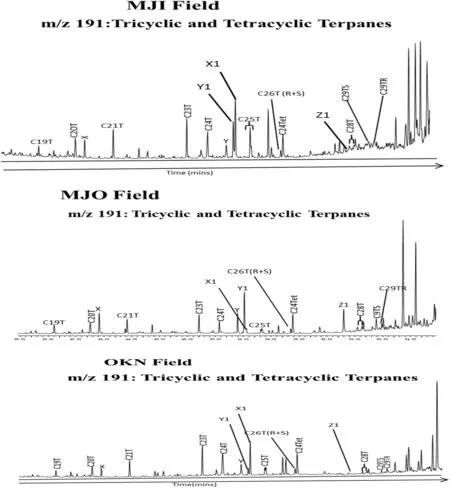
Fig.2 Partial m/z 191 mass fragmentograms showing the distribution of tricyclic and tetracyclic terpanes in the source rock extracts from Offshore Niger Delta Basin,Nigeria

Table 1 The relative abundance of tricyclic terpanes in the source rock extracts from the Offshore Niger Delta Basin,Nigeria
Also as shown in Fig.2,the distribution of tricyclic terpanes in MJI,MJO,and OKN rock extracts in the Offshore Niger Delta Basin is characterized by significant amounts of CT,an indication of the contribution of marine organic matter(Zhang and Huang 2005).Thus,the distribution patterns observed in the rock samples showed that they are derived from a mixed origin(terrestrial and marine)and deposited under oxic to suboxic conditions in lacustrine-fluvial/deltaic environments(Samuel et al.2009,2010;Huang et al.2015;Xiao et al.2018).The cross plots of the relative abundance of tricyclic terpanes against the samples and the histogram of the abundance of the samples clearly showed that CTT and CTT were the most abundant among the conventional tricyclic terpanes(Fig.3).The percentage of CTT-CTT compared to CTT has been successfully used to differentiate marine and terrigenous bitumens from Beypazari Basin,Central Anatolia,Turkey,and coals from Agwu formation,Lower Benue Trough,Nigeria(Ozcelik and Altunsoy 2005;Adedosu et al.2012).The CTT-CTT and CTT in the rock samples range from 50.08 to 74.17% and 25.83 to 49.92%,respectively(Table 1).These values provided additional information on the mixed origin(terrestrial and marine)of the rock samples.However,the higher percentage of CTT-CTT compared to CTT recorded for the samples suggests greater input of terrigenous organic matter compared to marine organic matter.
4.2 Origin of Niger Delta source rocks based on tricyclic and tetracyclic distribution
The ratios of different tricyclic terpanes have been applied as source facies indicators(Seifert and Moldowan 1978;Huang et al.2015).For instance,Peters et al.(2005)reported that oils from carbonate source rocks have lower values of CTT/CTT and that they could be differentiated from oils formed from lacustrine,marine shale and paralic(deltaic)shale source rocks by applying these parameters.Also,Ctetracyclic terpane/(Ctetracyclic terpane+Ctricyclic terpane)has been successfully used to determine the oil-formation organic source(Tao et al.2015).Moderately low CTT/CTT values indicate a normal marine,low carbonate source rock system,while CTeT/(CTeT+CTT)values>5 and<5 suggest terrigenous/freshwater lacustrine and marine/saline lacustrine source rocks,respectively In the present study,thevalues of CTT/CTT and CTeT/(CTeT+CTT)calculated for the rock samples range from 0.33 to 1.30 and 0.76 to 0.90,respectively(Table 2).These values show that the rock samples were formed from a mixed origin(terrestrial and marine)and deposited under oxic to suboxic conditions in lacustrine-fluvial/deltaic environments.The cross plots of CTeT/(CTeT+CTT)versus CTT/(CTT+CH)(Figs.4a)have been successfully used to differentiate the marine and non-marine oils from Tarim Basin,NW China(Hanson et al.2000;Duan et al.2008,Huang et al.2015;Tao et al.2015).The cross plots of these parameters show no significant variation in the majority of the samples,indicating source rocks formed from a similar source and depositional conditions(Fig.4).However,the three samples from OKN oilfield that grouped away from other samples may suggest different organic matter(Fig.4a).Furthermore,elevated values of CTT/CTT,CTT/CTT,CTT/CTT,and CTeT/CTT suggest a significant contribution from terrestrial organic matter while low values indicate marine origin(Hanson et al.2000;Preston and Edwards 2000;Volk et al.2005;Huang et al.2015).Also,previous data have shown that C/Ctricyclic terpane(C/CTT)and Ctricyclic terpane/Ctetracyclic terpane(CTT/CTeT)ratios>1 were related to marine oils,whereas the values<1 inferred non-marine oils(Burwood et al.1992;Hanson et al.2000).In this study,the values of CTT/CTT,CTT/CTT,CTT/CTeT,CTT/CTT,CTT/CTT,and CTeT/CTT in the rock samples range from 0.18 to 0.73,0.34 to 1.05,0.33 to 1.74,0.30 to 1.39,0.31 to 0.89 and 1.66 to 4.33,respectively(Table 2).These values indicate the source rocks formed from a mixed origin(terrestrial and marine)and deposited under oxic to suboxic conditions in the lacustrine-fluvial/deltaic environment.The cross plots of these parameters clearly show no much variation,suggesting source rocks from similar sources(Figs.4b,c,5a).Additionally,the values of(C+C+C)/(C+C)and(C+C)/Ctricyclic terpanes<1 indicate marine organic matter while values>1 suggest terrigenous organic matter(Tao et al.2015).In this study,the values of(C+C+C)/(C+C)and(C+C)/Ctricyclic terpanes in the rock samples range from 0.54 to 1.74 and 0.53 to 1.81,respectively(Table 2).These values further confirmed that the source rocks were formed from a mixed origin(terrestrial and marine)and deposited under oxic to suboxic conditions in lacustrine-fluvial/deltaic environments(Adedosu et al.2012;Tao et al.2015).Tao et al.(2015)have reported that the cross plots of Ctricyclic terpanes/Ctetracyclic terpane versus C/Ctricyclic terpanes(Fig.5a),(C+C+C)/(C+C)versus∑TTs/∑HOPs is(Fig.5b),C/Ctricyclic terpane versus(C+C)/Ctricyclic terpanes(Fig.5c),could be applied to evaluate the origin of organic matter.The plots clearly showed no significant variation,suggesting source rock samples derived from similar organic materials.Peters and Moldowan(1993)reported that CTT seems to indicate carbonate settings in marine source rocks and oils and that CTT/(CTT+CHOP)and CTT/CTT is higher for oils from a mixed origin(terrestrial and marine)(Tao et al.2015;Samuel et al.2010).In our study,the values of CTT/(CTT+CHOP)and CTT/CTT range from 0.01 to 0.32 and 0.94 to 2.10,respectively(Table 2).These values reflect source rocks derived from a mixed origin(terrestrial and marine),but the low values of CTT/(CTT+CHOP)recorded for the rock samples further suggest greater input of terrestrial organic matter relative to marine.
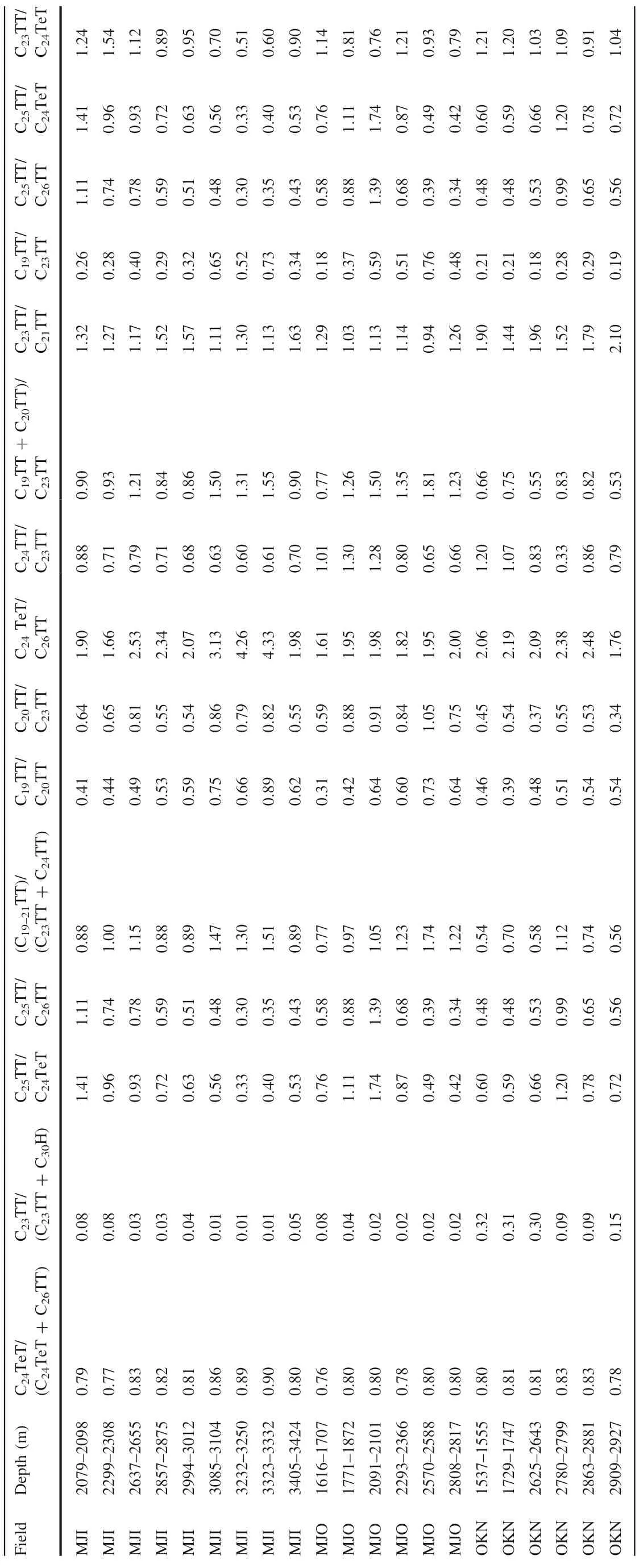
Table 2 The geochemical parameters based on tricyclic and tetracyclic terpanes in the source extracts from Niger Delta Basin,Nigeria

Table 3 Source facies,depositional environment and thermal maturity parameters calculated from source rock extracts from Niger Delta Basin,Nigeria
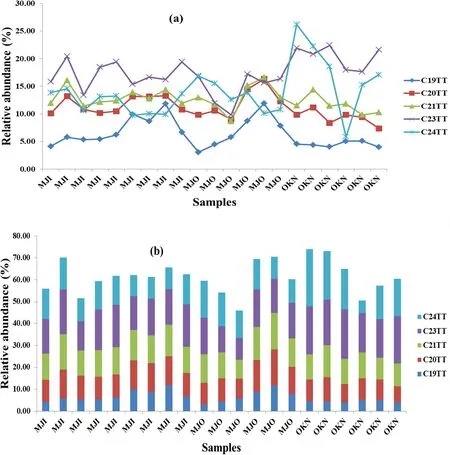
Fig.3 a Cross plots of the relative abundance versus samples and b histogram showing the abundance of tricyclic terpanes in the Offshore Niger Delta source rock extracts

Fig.4 Cross plots of a C24TeT/(C24TeT+C26TT)versus C23TT/(C23TT+C30H),b C19TT/C20TT versus C24TeT/C26TT,and c C20TT/C23TT versus C25TT/C26TT in source rock extracts from Offshore Niger Delta Basin,Nigeria

Fig.5 Cross plots of a C25 tricyclic terpanes/C24 tetracyclic terpane versus C25/C26 tricyclic terpanes,b(C19+C20+C21)/(C23+C24)versus∑TTs/∑HOPs,and c C23/C21 tricyclic terpane versus(C19+C20)/C23 tricyclic terpanes in the rock extracts from Offshore Niger Delta Basin,Nigeria
4.3 Depositional environment of Niger Delta source rocks based on tricyclic and tetracyclic distribution
The pristane/phytane(Pr/Ph)ratio is widely applied as an indicator for redox conditions in a paleo-depositional environment(Didyk et al.1978;Chandra et al.1994;Escobar et al.2011).The Pr/Ph ratios>3.0 suggest predominant terrigenous organic matter deposited under oxic conditions.Pr/Ph ratios<1.0 indicate marine organic matter deposited under anoxic/hypersaline conditions(Didyk et al.1978;Peters and Moldowan 1993;Peters et al.2005)while Pr/Ph values between 1.0 and 3.0 indicate terrestrial-marine organic matter deposited under suboxic conditions.In our study,the Pr/Ph values range from 1.51 to 4.53(Ogbesejana et al.2018a),(Table 3).This range of values suggests source rocks derived from a mixed origin(terrestrial and marine)and deposited under oxic to suboxic conditions in a lacustrine-fluvial/deltaic environment(Peters et al.2005;Ogbesejana et al.2018a,b).This interpretation is consistent with what has been inferred from tricyclic and tetracyclic terpanes data in the present study and recent studies on Niger Delta source rocks using aromatic biomarkers (Ogbesejana et al.2018a,b,2019a,b,c).In the present study,we noticed that the rock samples from MJO and MJI oilfields which are considered to be significantly terrestrial,have higher Pr/Ph(2.08 to 4.53,Table 3)which correlates with the higher Z1/(Z1+CTT)(0.38-0.83),and Y1/(Y1+CTT)(0.34-0.79)values(Table 3).This indicates that the source rocks from MJI and MJO oilfields were deposited under more oxic conditions,and these recently detected tetracyclic terpanes may have been formed in an oxidative environment(Xiao et al.2018).The rock samples from OKN oilfield show an intermediate value of the Pr/Ph ratio(1.51-2.61,Table 3)and moderate values of the Z1/(Z1+CTT)(0.36-0.62),and Y1/(Y1+CTT)(0.38-0.58)ratios(Table 3),indicating a sub-oxic environment.This indicates that the relatively higher abundance of these tetracyclic terpenes is usually associated with relatively higher values of the Pr/Ph ratio.Figures 6a,b indicate that the Z1/(Z1+CTT)and Y1/(Y1+CTT)values relate to the Pr/Ph values in the rock samples.In Figs.6c,d,the Z1/(Z1+CTT),and Y1/(Y1+CTT)ratios have similar attributes as the(C+C)TT/CTT ratio.Therefore,this further shows that these compounds are derived from source rock containing a mixed contribution of higher plant and marine source materials(Xiao et al.2018).
A ternary diagram on the relative abundance of C-CTTs(CTT,CTT,and CTT)has been successfully applied to differentiate the depositional environments of the source rocks and crude oils and the study showed that four typical sedimentary environmental zones,marine/saline lacustrine,freshwater lacustrine,fluvial/deltaic,and swamp,could be differentiated(Xiao et al.2019a,b).In the present study,the rock samples from the Offshore Niger Delta Basin almost grouped on the ternary plot of the relative abundance of C-Ctricyclic terpanes(Fig.7),inferring mixed input of marine and terrigenous organic matter deposited under oxic to sub-oxic in lacustrine-fluvial/deltaic sedimentary conditions(Xiao et al.2019a,b).
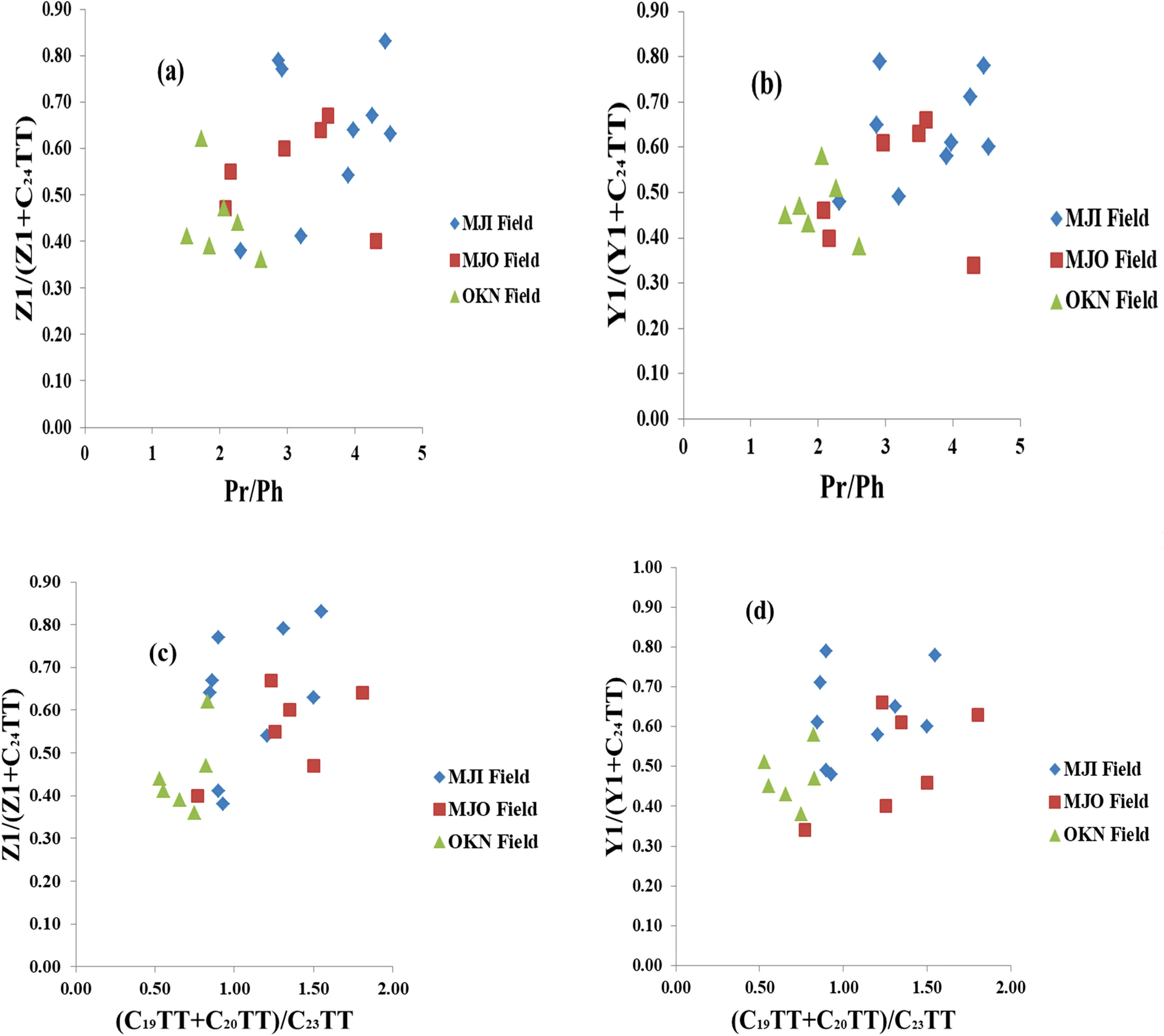
Fig.6 Cross plots of a Z1/(Z1+C24TT)versus Pr/Ph,b Y1/(Y1+C24TT)versus Pr/Ph,c Z1/(Z1+C24TT)versus(C19+C20)TT/C23TT,and d Y1/(Y1+C24TT)versus(C19+C20)TT/C23TT in source rock extracts from Offshore Niger Delta Basin,Nigeria

Fig.7 Ternary plots of C19TT-C23TT(tricyclic terpanes)in source rocks from Offshore Niger Delta Basin,Nigeria(after Xiao et al.2019b)
4.4 Influence of maturity on tricyclic and tetracyclic terpanes
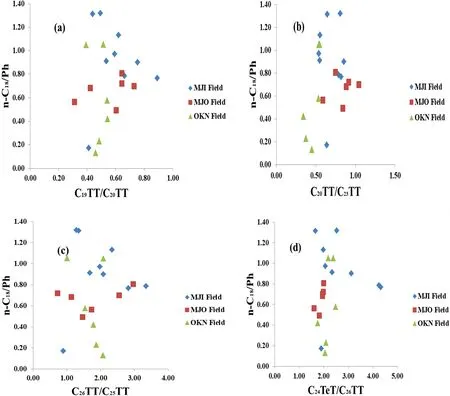
Fig.8 Cross plots of a C19T/C20T,b C20T/C23T,C26T/C25T and C24TeT/C26T versus n-C18/Ph in source rock extracts from Offshore Niger Delta Basin,Nigeria
The tricyclic terpanes have been successfully applied in thermal maturity evaluation.For instance,various tricyclic terpane ratios such as CT/CT(Ekweozor and Strausz 1983),CT/CT(Cassani et al.1988),CT/CT,CT/CT and CTeT/CT(Huang et al.2015;Tao et al.2015)have been proposed and applied to thermal maturity assessment based on the Ctricyclic terpane component which is usually dominant but becomes less prominent with increasing maturity.In this study,the values of CT/CT,CT/CT,CT/CT and CTeT/CT in the rock samples range from 0.31 to 0.89,0.34 to 1.05,0.94 to 2.10 and 1.76 to 4.33,respectively(Table 2).These values may probably indicate immature to early mature source rocks(Huang et al.2015;Tao et al.2015;Atoyebi et al.2017).Due to the more thermal stability and easy detection of nalkane/isoprenoid(n-C/phytane)ratio than tricyclic terpanes,they have been proposed as a good maturation proxy(Huang et al.2015).Thus,the cross plots of CT/CT,CT/CT,CT/CT and CTeT/CT versus n-C/Ph(Fig.8)show no significant variation,suggesting that these parameters are not affected by thermal maturity in the rock samples.Xiao et al.(2019b)have reported that thermal maturity has little effect on the distribution patterns of C-CTTs.The ratio of CTeT to the sum of the Ctricyclic terpanes(CTeT/CTT)and CTeT/Cαβ hopane ratio(CTeT/CHOP)have been applied to thermal maturity by Farrimond et al.(1999)and the authors found that CTeT/CTT values increased towards the oil window and then decreased again within the oil window while CTeT/CHOP showed a significant increase during the last part of the oil window.Tao et al.(2015)claimed that this attribute resulted from the initially higher rate of the tetracyclic terpanes generation relative to tricyclics,followed by more rapid thermal degradation in the later part of the oil window.In our study,the CTeT/CTT,CTeT/CHOP and CTT/CHOP range from 0.16 to 0.45,0.02 to 0.42 and 0.01 to 0.48,respectively(Table 3).This range of values suggests that source rocks are within immature to early mature stage.This result further supports the data obtained from other tricyclic and tetracyclic terpanes ratios in the source rocks.This interpretation is consistent with recent reports on the source rocks from the same depobelt in the Niger Delta Basin(Nigeria)using aromatic biomarkers(Ogbesejana et al.2018a,b,2019a,b,c).
5 Conclusion
The geochemical significance of tricyclic and tetracyclic terpanes in source rock extracts from the Offshore Niger Delta Bain,Nigeria was investigated with gas chromatography-mass spectrometry(GC-MS).Among the tricyclic and tetracyclic terpanes identified in the rock extracts,the conventional(CT,CT,CT,CTeT)and recent(Y1,X1,Z1)were more prominent than all others,indicating mixed input of terrigenous and marine organic matter.The source facies,depositional environments and thermal maturity based parameters calculated from the tricyclic and tetracyclic terpanes in the rock extracts showed that the rock samples were formed from mixed input of terrigenous and marine organic matter and deposited under oxic to suboxic conditions in a lacustrine-fluvial/deltaic environments within immature to early mature stage.Thus,this study showed that tricyclic and tetracyclic terpanes were effective in determining the origin,depositional environments,and thermal maturity of source rocks in the Niger Delta Basin,Nigeria.
Acknowledgements
The authors thank the Department of Petroleum Resources of Nigeria and Chevron Nigeria Limited for providing the rock samples.A.B.Ogbesejana appreciates Cheng Quan and Zhao Jiang for their assistance in the laboratory works,and Prof.Zhong Ningning for the vital roles in securing funding and care during his visit to the State Key Laboratory of Petroleum Resources and Prospecting,China University of Petroleum,Beijing China towards this research.This paper benefitted immensely from the constructive advice of Prof.Meijun Li of the State Key Laboratory of Petroleum Resources and Prospecting,China University of Petroleum Beijing,China.The authors gratefully acknowledge the State Key Laboratory of Petroleum Resources and Prospecting,College of Geoscience,China University of Petroleum,Beijing,China for granting A.B.Ogbesejana an international visiting research fellowship towards this research work.A.B.Ogbesejana appreciates Prof.Zhong Ningning for the vital he played in securing funding and care during his visit to the State Key Laboratory of Petroleum Resources and Prospecting,China University of Petroleum,Beijing China towards this research.Compliance with ethical standards
Conflict of interest
On behalf of all authors,the corresponding author declares that there is no conflict of interest in this research work.- Acta Geochimica的其它文章
- Geochronology,geochemistry and Hf isotopes of andesites in the Sandaowanzi gold deposit(Great Xing’an Range,NE China):implications for petrogenesis,tectonic setting,and mineralization
- Geochemical characterization of the salinity of irrigated soils in arid regions(Biskra,SE Algeria)
- Adsorption experiment of water-soluble rare earth elements in atmospheric depositions and implications for source tracing in South China
- Effects of geosorbent and solution properties on sorption and desorption of PAHs
- Paleoclimate evolution and aridification mechanism of the eastern Tethys during the Callovian-Oxfordian:evidence from geochemical records of the Qiangtang Basin,Tibetan Plateau
- Estimation of evaporation losses based on stable isotopes of stream water in a mountain watershed

